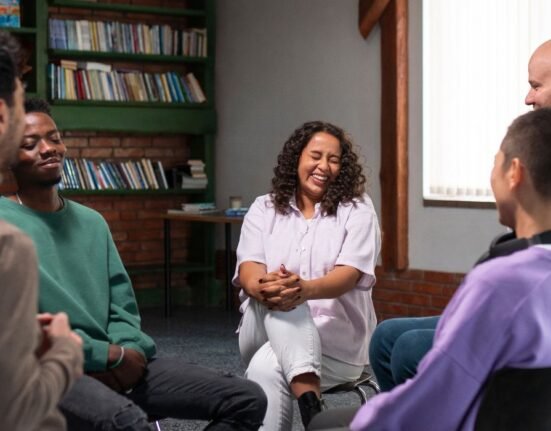In today’s world, it is interesting to understand the psychological effect of rewatching known content. American adults watch an average of 11 hours per day, consuming various forms of media (Kaur, 2021, pages 31-35), stressing its central role in shaping emotional experience. So much high consumption has raised increased interest in how the media functions as a coping mechanism in times of distress.
Returning to the known material in the form of movies, TV shows, or music provides people with comfort and emotional security. Not only does viewing familiar stories make a person happy, but it also weans one from mental exhaustion and fortifies the neural pathways (Huang & Sze, 2025). This was particularly evident during collective trouble situations, like the COVID-19 pandemic, when individuals employed their preferred content to offer solace (Kaur, 2021, pages 1-5).
The phrase “comfort watching” best captures the sense of familiarity and pleasure. Analysing the popularity of recognised content reveals underlying viewing media behaviour patterns. Nostalgia forms the basis of TV preference, especially in times of uncertainty (addressed in section 2). Nostalgic TV induces a sense of security and familiarity, basically erasing concern (Kaur, 2021, pages 1-5; Kaur, 2021, pages 41-45). While watching, viewers satisfy entertainment requirements while connecting with content, releasing good emotions.
This essay will explore the relationship between re-watching and its psychological impact and examine such behaviour as a coping strategy. Drawing on the findings of research into nostalgia and coping strategies, this research will add to the study of the behaviour of re-watching as an academic subject of research and as a healthy behaviour for improving mental health.
Read More: The Comfort Show Effect
Why Our Brains Crave Familiar Stories?
Re-watching familiar media is a complex activity that is entangled with emotion regulation, nostalgia, and familiarity. Emotional regulation is a key psychological process that involves the control and elaboration of emotional incidents in a way that maximises well-being. Psychological theory dictates that individuals are most likely to use an array of stress and emotional control coping strategies, whereby popular media is regarded as an effective medium (as quoted in Kaur, 2021, pages 26-30).
Familiar media stimulates positive definite affective reactions, specifically of security and comfort. The link results from the consolidation of neural connections; repeated exposure to familiar content reduces mental effort and creates psychological comfort (Huang & Sze, 2025). Case studies indicate that watching movies or TV shows again enables individuals to exercise emotion regulation through repeated exposure to narratives that stimulate nostalgia with implications of stability and childhood memories (Kaur, 2021, pages 1-5).
Nostalgia is distinct, particularly when relating to comfort-seeking behavioural analysis. Nostalgia refers to a sentimental yearning for something in the past. It has a deep impact on watching the media. During difficult or stressful times, of course, they move to watch nostalgic TV shows or movies as an escape (Kaur, 2021, pages 46-50). This comfort-seeking is not limited to passive reception behaviour; it affects the thought process of an individual to the extent of providing comfort through familiar characters and familiar storylines.
Real-life situations also show this phenomenon. Other people speak of resorting to loved films during stressful times, and it proves the psychological desire for predictability in media experience (Miller, 2024, pages 1-5). Familiarity in such narratives gives a feeling of security that tends to de-escalate anxiety and depression feelings and make it easier for a person to relate to their own feelings. Predictability is also required in the viewer experience. Studies show that reassuring, predictable plot constructions allow audience members to know what is coming next and thus improve their entire viewing experience (Miller, 2024, pages 6-10).
Predictability varies across genres: romantic comedy, for example, has predictable models which are comforting to watch compared to dramatic scripts riddled with ambiguity. Comparison of genres shows how audience tastes are aligned with their psychological demands; if they need to escape conflict, then they will gravitate towards the formulaic narrative genre and not towards the more problematic or indeterminate kind of narrative.
Understanding such dynamics gives reason why audiences constantly return to re-viewing known content in the uncertainty of life; it is not only entertainment but an exercise they need to be emotionally stable and resilient through experiences with nostalgia.
Read More: The Psychology behind why do we Rewatch old movies and TV shows
The Emotional Rewards of the Rewatch
Re-viewing known media speaks to a multilateral engagement of emotional management, nostalgia, and reassurance through habitual narrative. Research has established that exposure to familiar programming is a coping strategy for resilience during adversity. The main findings identify that familiarity plays an important part in the viewers’ mental health.
For instance, Miller’s work illustrates that binge-viewing familiar programs is linked with less depression than unfamiliar TV (Miller, 2024, pages 1-5). Kaur’s study is justified above by the acceptance of comfort films as tools for stress relief (Kaur, 2021, pages 26-30). Nostalgia reduces emotional pain by familiarity, consolation provided by known stories, and audiences being able to empathise with beloved tales through minimal mental resources (www.weraddicted.com, 2025).
These conclusions carry a significant impact on media makers, who can turn to hungry viewers seeking emotional nourishment. It can be interpreted in producing sequels or spin-offs that are retro but incorporate understated narrative development. Hints of predictability in the form of steady character arcs or repetitive motifs can be utilised to invite viewer engagement.
From a promotional angle, the comprehension of the draw of nostalgia programming allows for successful promotion. Promotion of familiarity and emotional attachment can ensnare viewers in search of comfort during trying times. Positioning audience relationships with favorite programming in contrast to mere new shows can capitalise on proven emotional attachment.
The cause for this tendency towards familiar narrative can be found in the continued popularity of certain television shows and film franchises. Programs like Friends, The Office, or Harry Potter films are seen again and again by viewers seeking comfort. The familiar characters and storylines of these beloved tales are a comforting presence, a predictable haven from the chaos of daily life. This is why bingeing on an old favourite for a few hours will feel so much like hugging the brain.
Additional research should explore re-viewing behaviour by population, including what cultural context, age, and individual experience have on choice (Carpentier et al., 2008). A study of the influence of global events on media use for familiarity could also be enlightening (Schramm & Cohen, 2017). In summary, understanding these dynamics provides us with more understanding about why individuals are drawn to familiar content during life’s adversity. See also Peters (2024).
Read More: The Science Behind How Nostalgia Fuels Optimism
Embracing the Familiar: Your Personal Comfort Playlist
Repeated viewing of media is a powerful behavioural trend with deep psychological links. It’s an excellent way of coping with uncertainty by activating the power of knowing and nostalgia to de-stress and relax. The exercise is reassuring psychologically since the content provides predictability and emotional balance.
Research shows that watching a familiar series or movie is a way of emotional regulation because stressed-out people automatically move towards known stories. The content reduces the brain’s cognitive load, allowing emotional regulation without the accompanying anxiety that an unknown plot may trigger. Miller’s (2024) writing even talks about the pros of binge-watching such familiar shows as a way of overcoming loneliness and being comforted in bad times.
There are two reasons for doing this. The majority of people view shows over and over again in an effort to reassert emotional connections they have established previously. The predictable storylines give a feeling of security, filling the void in an otherwise uncertain world. This repetition of comforting narratives is a way of enjoying and reasserting good things.
While comfort media is great for one’s psychological well-being, there is also a need to balance it with fresh content so that there is growth as an individual and not stagnation (Khanbeigi, 2023). For content creators, knowing about this requirement of nostalgia can assist them in creating emotionally invested television shows that enhance audience engagement. By invoking a sense of commonality, the shows can create a sense of community and enhance audience enjoyment. Ultimately, re-watching comfort media is all about the psychological desire for comfort and connection, transforming favourite stories into shared experiences.
Read More: The Influence of Movies and Music on Mental Health
References +
Emma Miller. (2024). The Relationships Between Indulgent-Watching Behaviour, Content Familiarity, Depression, and Anxiety.https://digitalcollections.lipscomb.edu/cgi/viewcontent.cgi?article=1003&context=psy_graduate
Sohni Kaur. (2021). THE COMFORT WATCH: PSYCHOLOGY AND MEDIA THEORY PERSPECTIVES ON NOSTALGIA AND FILM.https://scholarship.claremont.edu/cgi/viewcontent.cgi?article=2772&context=scripps_theses
Melenie Huang, Angelina Sze. (2025). The Psychology of Rewatching. https://stuyspec.com/article/the-psychology-of-rewatching
Scarlett Khanbeigi. (2023). The Psychology Behind Comfort Media. https://olumuse.org/2023/02/15/the-psychology-behind-comfort-media/
Francesca R Dillman Carpentier, Jane D Brown, Michele Bertocci, Jennifer S Silk, Erika E Forbes. (2008). Sad Kids, Sad Media? Applying Mood Management Theory to Depressed Adolescents’ Use of Media. https://pmc.ncbi.nlm.nih.gov/articles/PMC2746648/
Comfort in the Familiar: Why We Watch the Same TV Shows Over and Over Again. (2025). https://www.weraddicted.com/comfort-in-the-familiar-why-we-watch-the-same-tv-shows-over-and-over-again/
Peters. Heinrich. (2024). Modelling User Engagement on Online Social Platforms – A Context-Aware Machine Learning Approach.https://academiccommons.columbia.edu/doi/10.7916/dtsk-xr71
Holger Schramm, Elizabeth L. Cohen. (2017). Emotion Regulation and Coping via Media Use.https://www.researchgate.net/publication/314394906_Emotion_Regulation_and_Coping_via_Media_Use
Why We Watch the Same Shows Over and Over | Psychology Today. (2022). https://www.psychologytoday.com/us/blog/defining-memories/202212/play-and-repeat-why-we-watch-the-same-shows-over-and-over













Leave feedback about this